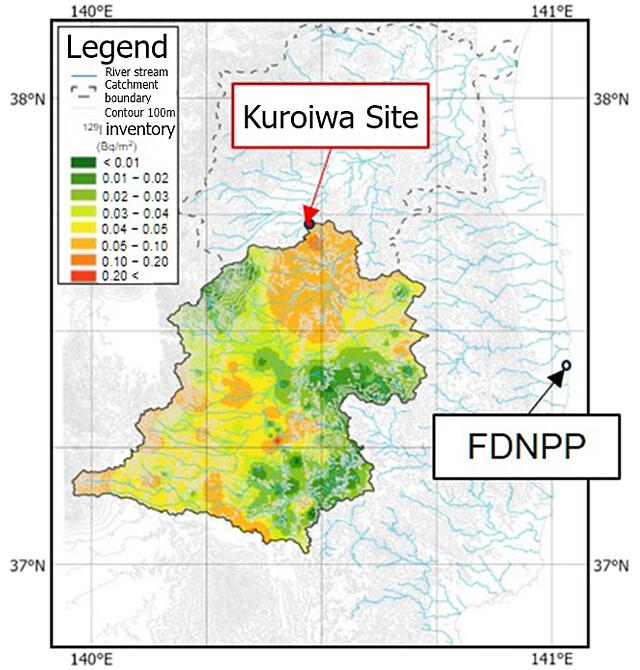On November 13, a research group led by Associate Professor Yoshifumi Wakiyama of the Institute of Environmental Radioactivity at Fukushima University, in collaboration with CRiES, the University of Tsukuba, and the Institute of Nature and Environmental Technology, Kanazawa University, announced that they measured the concentration of iodine-129 in the Abukuma River and found it to be equivalent to the levels before the accident at the Fukushima Daiichi Nuclear Power Plant. Iodine-129 is a radionuclide released during the accident, but only few studies have investigated its concentration in river water. The results are expected to be an important environmental assessment and lead to a better understanding of the global cycle of iodine-129 and were published in the international journal Applied Geochemistry.

Provided by Fukushima University, the University of Tsukuba, and Kanazawa University
The accident at the Fukushima Daiichi Nuclear Power Plant in 2011 resulted in the release of various radionuclides, including radioactive cesium. Iodine-129 is a radionuclide with a long half-life of 15.7 million years. The amount of iodine-129 released during the accident is estimated to be between 5.2 and 7.3 GBq, of which 2.7 GBq was deposited on land. Since the accident, studies investigating the amount and movement of iodine-129 in soil, rainwater, seawater, etc. have been conducted. However, few studies have analyzed these aspects in river water; consequently, little knowledge is available regarding its movement in this environment.
The research group analyzed water samples collected at the Kuroiwa site in the middle reaches of the Abukuma River during periods of high-water levels from July 5 to 7 and October 1 to 4, 2018 and measured the iodine-129 concentration. A total of 12 samples was collected, and measurements were performed on filtrate and suspended solids obtained by filtration using an accelerator mass spectrometer at the University of Tsukuba. The iodine-129 concentration in suspended solids (mBq/kilogram) and dissolved iodine-129 concentration (µBq/liter) were analyzed. Additionally, the data obtained were used to determine the concentration levels and their changes during floods and the amount of iodine-129 flowing through the river. This data was compared with published data on cesium-137 at the same location and over the same period of time to capture the movement of iodine-129 in the environment.
The results showed that the concentration of iodine-129 in the Abukuma River was equivalent to the level before the Fukushima Daiichi Nuclear Power Plant accident. The average concentration of dissolved iodine in the 12 samples was 0.11 µBq/liter and that of iodine-129 in suspended solids was 0.67 mBq/kg. Considering concentration changes during flooding, the dissolved concentrations of iodine-129 and cesium-137 tended to decrease over time. Furthermore, the concentration of cesium-137 in suspended solids was higher at the peak of flooding, while that of iodine-129 tended to fluctuate and decrease. This difference is attributed to the fact that cesium is strongly retained by clay minerals in suspended solids, while iodine is more easily retained by organic matter.
Based on the obtained iodine-129 concentrations, the estimated amount of iodine-129 flowing at the Kuroiwa site was 9,900 Bq in the July 2018 survey and 22,000 Bq in the October 2018 survey, indicating that 83% and 27% of the discharge was dissolved, respectively. Mostly, iodine flowed in the dissolved form; however, when the suspended matter concentration increased due to rising water levels, the amount of iodine flowing in the suspended form became predominant.
The results indicate that iodine-129 is more mobile in water than cesium-137. The amount of iodine-129 that released was four to five orders of magnitude smaller than that of cesium-137. Wakiyama said, "We have received tremendous support from various fields for this study, from the execution of this research to the publication of the results. On behalf of the collaborators, I want to thank everyone who has supported us at ERAN (Environmental Radioactivity Research Center) and at various institutions. We will continue our efforts to discover scientific knowledge and return it to society."
Journal Information
Publication: Applied Geochemistry
Title: Riverine 129I dynamics during high-flow events on the Abukuma River in Fukushima
DOI: 10.1016/j.apgeochem.2024.106134
This article has been translated by JST with permission from The Science News Ltd. (https://sci-news.co.jp/). Unauthorized reproduction of the article and photographs is prohibited.




